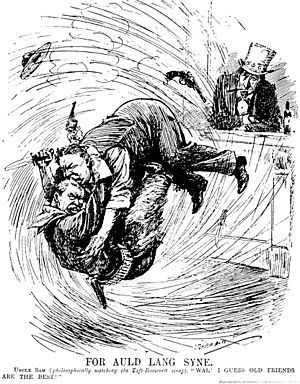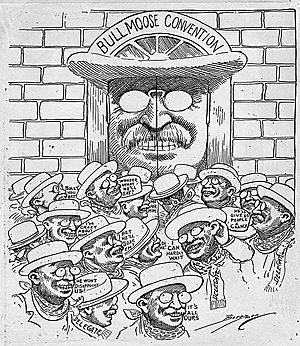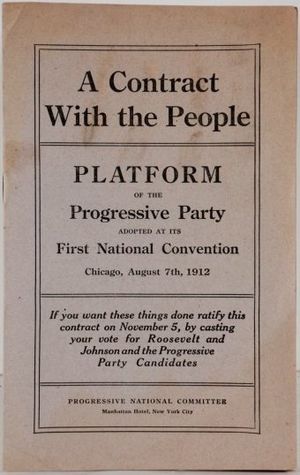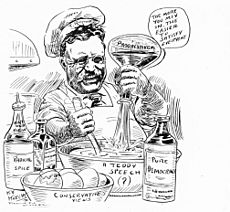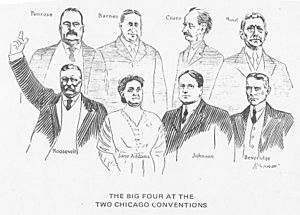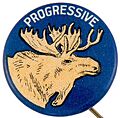Progressive Party (United States, 1912–1920) facts for kids
Quick facts for kids
Progressive Party
|
|
|---|---|
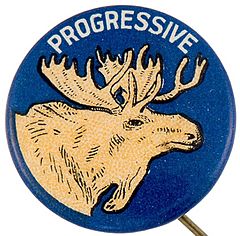
The bull moose was the party's official mascot
|
|
| Chair | Theodore Roosevelt |
| Founded | 1912 |
| Dissolved | 1920 |
| Split from | Republican Party |
| Preceded by | Lincoln–Roosevelt League |
| Merged into | Republican Party (majority) |
| Succeeded by | California Progressive Party |
| Headquarters | Washington, D.C., U.S. |
| Ideology | Progressivism Radicalism New Nationalism |
| Political position | Left-wing |
| Colors | Red |
The Progressive Party was a new political group in the United States. It was started in 1912 by former president Theodore Roosevelt. He formed the party after he lost the chance to be the Republican Party's presidential candidate. The person who won instead was the current president, William Howard Taft, who used to be Roosevelt's friend.
This new party was known for supporting many modern changes, called progressive reforms. It attracted many important reformers from around the country. The party was also linked to America's history of wanting big changes.
After the party lost the 1912 U.S. presidential election, it quickly became less popular. By 1920, it had mostly disappeared. People often called the Progressive Party the "Bull Moose Party." This nickname came from Roosevelt himself. After losing the Republican nomination in June 1912, he said he felt "strong as a bull moose!"
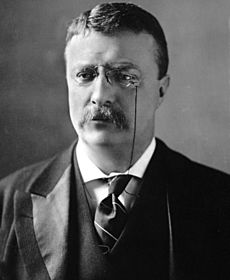
Theodore Roosevelt was a Republican. He was president from 1901 to 1909. Towards the end of his time in office, he became more and more interested in progressive ideas. In the 1908 United States presidential election, Roosevelt helped his Secretary of War, William Howard Taft, become the next president.
Taft wanted to continue Roosevelt's plans for the country, called the Square Deal. However, Taft made some mistakes that caused problems within the Republican Party. These problems made Roosevelt and Taft, who were once friends, become rivals.
Another progressive Republican leader, Robert M. La Follette, had already planned to challenge Taft for the 1912 Republican nomination. But when Roosevelt decided to try for a third term as president, many of La Follette's supporters switched to Roosevelt. At the Republican meeting in 1912, Taft barely won the nomination over Roosevelt.
After this, Roosevelt and other progressive Republicans started the Progressive Party. They chose Roosevelt as their presidential candidate and Hiram Johnson of California as his running mate. Some Republican politicians joined the new party, but most stayed with the Republican Party. In California, however, Johnson and the Progressives took control of the Republican Party there.
Contents
What the Progressive Party Wanted
The party's main ideas were based on Roosevelt's "Square Deal" plan. They called for many progressive changes. The party said that their most important goal was "to dissolve the unholy alliance between corrupt business and corrupt politics." This meant they wanted to stop bad connections between big businesses and politicians.
The party's ideas included:
- Making rules for how money is given to political campaigns.
- Lowering taxes on imported goods, called tariffs.
- Creating a system of social insurance to help people.
- Having an eight-hour workday.
- Giving women the right to vote.
Some party members disagreed about how to control large companies. Others, like Jane Addams, who was a pacifist (someone against war), did not like Roosevelt's idea of building up the navy.
The 1912 Election and After
In the 1912 election, Roosevelt got 27.4% of the votes. Taft got 23.2%. This made Roosevelt the only third-party candidate in U.S. history to get more votes than a major party's candidate. However, both Roosevelt and Taft lost to Democratic candidate Woodrow Wilson. Wilson won with 41.8% of the votes and most of the electoral votes.
The Progressives elected some people to Congress and state governments. But the election mainly helped the Democratic Party gain power.
In 1916, the Progressive Party held its meeting at the same time as the Republican Party. They hoped Roosevelt would become the presidential candidate for both parties. But Roosevelt refused the Progressive nomination. He told his supporters to vote for Charles Evans Hughes, who was the Republican candidate.
After Roosevelt refused, the Progressive Party fell apart. Most Progressives went back to the Republican Party. Some joined the Democratic Party. Later, some former Progressives, like Harold L. Ickes, worked in President Franklin D. Roosevelt's government.
Other Progressive Parties were formed later. Robert M. La Follette started one in 1924. Another was started in 1948 by former vice president Henry A. Wallace.
Roosevelt vs. Taft
Roosevelt had chosen Taft to be president after him because he thought Taft shared his views. Taft easily won the 1908 election. But Roosevelt became unhappy with Taft's more conservative decisions. Roosevelt was especially upset when Taft used a law called the Sherman Anti-Trust Act against a company that Roosevelt had approved of.
They became open enemies, and Roosevelt decided to run for president again in early 1912. Taft was already facing a challenge from Senator Robert La Follette. Most of La Follette's supporters then switched to Roosevelt.
Nine states had primary elections where voters chose their preferred candidate. Roosevelt won these. But Taft had worked harder to control the Republican Party's organization. He secured votes from delegates in Southern states, using a method Roosevelt himself had used before. The Republican Party's national meeting rejected Roosevelt's complaints. Roosevelt and his supporters walked out, and the convention chose Taft again.
Starting the New Party
The day after the Republican meeting, Roosevelt's supporters met to create their own political party. California Governor Hiram Johnson became its leader. They planned another meeting for August.
Wealthy supporters provided most of the money for the new party. Magazine publisher Frank A. Munsey gave $135,000, and financier George Walbridge Perkins gave $130,000. Roosevelt's family gave $77,500, and others gave $164,000. In total, they had almost $600,000, which was less than the major parties.
Key leaders in the new party included Jane Addams of Hull House, who was important in social work and women's rights. Also, former Senator Albert J. Beveridge supported regulating industries. Gifford Pinchot, a leading environmentalist, was also involved. Publishers who exposed corruption, like Frank Munsey and Frank Knox, joined too. The main organizers were Senator Joseph M. Dixon and George Walbridge Perkins. Perkins, who worked for a big bank, managed the party's organization. However, his ties to Wall Street made some party members distrust him.
The new party had some problems. To support Roosevelt, Republican politicians had to leave their old party, which was risky for their careers. Only a few Republican senators joined the new party. Very few Democrats ever joined. However, many independent reformers did sign up. Most of Roosevelt's former political friends stayed with Taft, including his son-in-law, Nicholas Longworth.
The Progressive Convention
Despite challenges, the August meeting was very exciting. Over 2,000 people attended, including many women. In 1912, neither Taft nor Wilson supported women's right to vote across the country.
A famous supporter of women's rights, Jane Addams, spoke in favor of Roosevelt's nomination. Roosevelt was chosen as the candidate, with Johnson as his running mate.
The most important part of the meeting was creating the party's platform. This platform explained what the new party promised voters. It included many social and political changes that progressives had wanted for a long time. Roosevelt himself said, "Our cause is based on the eternal principle of righteousness."
The platform's main idea was to stop big businesses from controlling politics. It said that both the Republican and Democratic parties were controlled by business interests. The platform stated:
To destroy this invisible Government, to dissolve the unholy alliance between corrupt business and corrupt politics is the first task of the statesmanship of the day.
To achieve this, the platform called for:
- Strict rules and public reports for money given to political campaigns.
- Registering people who try to influence laws (lobbyists).
- Recording and publishing what happens in Congress meetings.
For social issues, the platform wanted:
- A national health service.
- Social insurance for the elderly, unemployed, and disabled.
- Limiting judges' power to stop worker strikes.
- A minimum wage law for women.
- An eight-hour workday.
- A federal group to oversee investments (securities commission).
- Help for farmers.
- Money for workers hurt on the job.
- A tax on inherited money.
The political changes proposed included:
- Women's right to vote.
- Direct election of senators by the people.
- Primary elections for choosing candidates.
- Making it easier to change the United States Constitution.
The platform also encouraged states to use "direct democracy" tools like:
- The recall election (voters can remove an elected official).
- The referendum (voters can decide on a law).
- The initiative (voters can propose a law).
- Judicial recall (voters can overturn a court's decision).
The platform also wanted to lower tariffs and limit naval weapons through international agreements. It also called for a national health service, making Roosevelt one of the first major politicians to suggest health care reform.
A big debate at the meeting was about how to deal with large companies and monopolies. The meeting first approved a strong plan to break up "trusts." But Perkins changed it to talk only about "strong National regulation" and "permanent active Federal supervision" of big companies. This change upset reformers like Pinchot and caused a deep split in the party.
Overall, the platform showed Roosevelt's "New Nationalism." This idea meant a strong government should regulate industries, protect workers, and lead big national projects. This was different from Wilson's idea of "New Freedom," which focused more on individual freedom. However, once Wilson became president, his plans ended up being similar to Roosevelt's.
Roosevelt also believed in a strong foreign policy and a powerful military. Even though the platform called for limiting naval weapons, it also suggested building two new battleships each year. This worried pacifists like Jane Addams.
The 1912 Election Campaign

Roosevelt campaigned very hard, but his campaign did not have much money. The businesses that had supported him before either backed other candidates or stayed neutral. Roosevelt also faced a challenge because he had already served almost two full terms as president. There was an unwritten rule against a president serving a "third term."
In the end, Roosevelt did not win. He received 4.1 million votes, which was 27% of the total. This was less than Wilson's 42% but more than Taft's 23%. Socialist candidate Eugene Debs got 6%. Roosevelt received 88 electoral votes, while Wilson got 435 and Taft got 8.
This was still the best result for any third party since 1864. Roosevelt was the only third-party candidate to get more votes than a candidate from a major established party. The split in the Republican Party was key to Wilson winning the presidency.
On October 14, 1912, while Roosevelt was campaigning, a man shot him. The bullet hit his chest but was slowed down by his eyeglass case and a folded speech in his pocket. Roosevelt, an experienced hunter, knew the bullet had not reached his lung because he was not coughing blood. He refused to go to the hospital right away. Instead, he gave his planned speech, even with blood soaking his shirt. He spoke for 90 minutes before getting medical help.
His first words to the crowd were: "Ladies and gentlemen, I don't know whether you fully understand that I have just been shot, but it takes more than that to kill a Bull Moose." Doctors decided it was safer to leave the bullet in his chest, and he carried it for the rest of his life. Both Taft and Wilson stopped their campaigns until Roosevelt recovered. When asked if the shooting would affect his campaign, Roosevelt said, "I'm fit as a bull moose," which inspired the party's symbol.
State and Local Efforts
Ohio was a very active state for the new party. In November 1911, some Ohio Republicans supported Roosevelt for president. This was important because Ohio was President Taft's home state. Roosevelt later said, "I am really sorry for Taft... He is utterly unfit for leadership." In January 1912, Roosevelt said he would serve if the people wanted him to.
The big test came in Ohio's primary election on May 21, 1912. Both Taft and Roosevelt campaigned fiercely. Roosevelt traveled 1800 miles in Ohio, giving 75 speeches. Taft traveled 3000 miles, giving over 100 speeches. Roosevelt won in Ohio, which made him campaign even harder.
Most Progressive candidates were in states like New York, Ohio, Indiana, Illinois, and Massachusetts. Very few were in the South. In California, Governor Hiram Johnson, a close friend of Roosevelt, controlled the state Republican Party. He became Roosevelt's running mate, and they won California.
Only about a third of the states held primary elections. In other states, the party organization chose delegates for the national meeting, and they usually favored Taft. The national committee, controlled by Taft's men, made the final decisions about who could be a delegate.
Progressive candidates usually received between 10% and 30% of the votes. Nine Progressives were elected to the House of Representatives, but none won governorships. About 250 Progressives won local offices. In November, the Democrats benefited from the Republican split. They gained many seats in state legislatures and in the U.S. House and Senate.
1914 Elections
Even though they came in second in 1912, the Progressive Party did not disappear right away. In 1914, 138 candidates, including women, ran for the U.S. House as Progressives. Five of them were elected. However, almost half of the candidates got less than 10% of the votes.
Gifford Pinchot came in second in the Senate election in Pennsylvania, getting 24% of the votes.
Hiram Johnson was not chosen to run for governor as a Republican again. So he ran as a Progressive and was re-elected governor of California. Seven other Progressives ran for governor, but none got more than 16% of the votes. Some state parties remained quite strong. In Washington, Progressives won a third of the seats in the state legislature.
1916 Elections
Earlier in 1916, Louisiana businessman John M. Parker ran for governor as a Progressive. The Republican Party was not popular in Louisiana. Parker got a good 37% of the votes and was the only Progressive to run for governor that year.
Later that year, the party held its second national meeting. It was held at the same time as the Republican National Convention to make it easier for the parties to reunite. Five delegates from each meeting talked, and the Progressives wanted to reunite with Roosevelt as the candidate. But the Republicans strongly disagreed.
Meanwhile, Charles Evans Hughes, a moderate progressive, became the top choice at the Republican meeting. He had been on the Supreme Court in 1912, so he was neutral in the arguments from that year. The Progressives suggested Hughes as a compromise candidate. Then Roosevelt sent a message suggesting a conservative senator, Henry Cabot Lodge. The shocked Progressives immediately nominated Roosevelt again, with Parker as his running mate.
But Roosevelt refused the nomination. He told his supporters to vote for Hughes, who was then approved by the Republican meeting. The national Progressive Party quickly fell apart. Most Progressives, including Roosevelt, went back to the Republican Party. Hiram Johnson was elected to the Senate as a Republican. Some leaders, like Harold L. Ickes, supported Wilson.
1918 Elections and Later
All the remaining Progressives in Congress rejoined the Republican Party, except for Whitmell Martin, who became a Democrat. No candidates ran as Progressives for governor, senator, or representative in 1918.
Robert M. La Follette Sr. had a big disagreement with Roosevelt in 1912. He later ran for president on his own ticket, the 1924 Progressive Party, in the 1924 United States presidential election.
From 1916 to 1932, the part of the Republican Party that supported Taft was in control. They refused to nominate any important 1912 Progressives for national office. Finally, Frank Knox was nominated for vice president in 1936.
Many former Progressives did not have a clear political home until the 1930s. Then, most of them joined the New Deal Democratic Party, which supported President Franklin D. Roosevelt.
Images for kids
See also
 In Spanish: Partido Progresista (Estados Unidos, 1912) para niños
In Spanish: Partido Progresista (Estados Unidos, 1912) para niños
- Committee of 48
- Lincoln–Roosevelt League, the California Progressive Party in the early 1900s
- Populist Party (United States)
- Progressive Party (United States, 1924)
- Progressive Party (United States, 1948)
- California Progressive Party
- Oregon Progressive Party
- Wisconsin Progressive Party
- Minnesota Progressive Party
- Vermont Progressive Party



